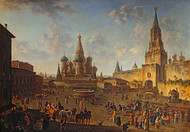Fyodor Yakovlelich Alekseyev/ Fedor Alekseev
Published by Therese Myles on 1st Oct 2019
Born in St. Petersburg, Russia in 1753, Fyodor Alekseyev was frequently referred to as “the Russian Canaletto”, a reference to Giovanni Antonio Canal. He is considered to be the first Russian painter to successfully paint city and town landscaping arts. Initially he studied at a Garrison school, a school for the children of military recruits in Russia. However, he was admitted to the Imperial Academy of Arts in St. Petersburg in1764 after a petition was started by his father who worked as a caretaker. While at the Imperial Academy of Arts, he studied scenic painting with Antonio Peresinotti, as well as took a class focusing on ornamental sculpture.
He moved to Venice as part of a fellowship in 1773, where he was directed by authorities at the Academy to study as a theater artist, something that he did not want to do. As a result, he devoted most of his time to replicating the work of other artists and painting landscapes. After returning to the Academy in 1777, he was punished for his blatant disobedience by being made to work in the Theater Decoration School until 1786 and his ability to continue his academic studies was suspended. However, he continued to paint what he wanted and slowly started to earn recognition throughout the art community.
He 1794, he earned the coveted tine of Academician, meaning he was a full member of a literary, art, or scientific community, after his View of the Palace Embankment from the Fortress was revealed. Due to his impressive vedutes (large-scale paintings of a cityscape with particular attention to details), Tsar Paul I requested that he paint a vedute of the architecture and streets of Moscow in 1800. In 1803, he taught at the Academy in St. Petersburg, while also traveling extensively through Russia. During his travels he often created open air watercolors and sketches of his surroundings.
In 1810, Alekseev painted various works highlighting the city of St. Petersburg. Some of his most famous works include St.Nikolai’s Gate in Kitai-Gorod (1800s), The North Side of Red Square (1802), Cathedral Square during the Coronation of Alexander I (1802), and his final painting, The Flood of 1824 in the Square at the Bolshoi Kamenny Theatre (1824).
Although he was a well-known painter, his fame declined as aged. At the time of his death on November 23, 1824 in St. Petersburg, he was living a life of poverty. As a result, the Imperial Academy of Arts paid for his funeral.

